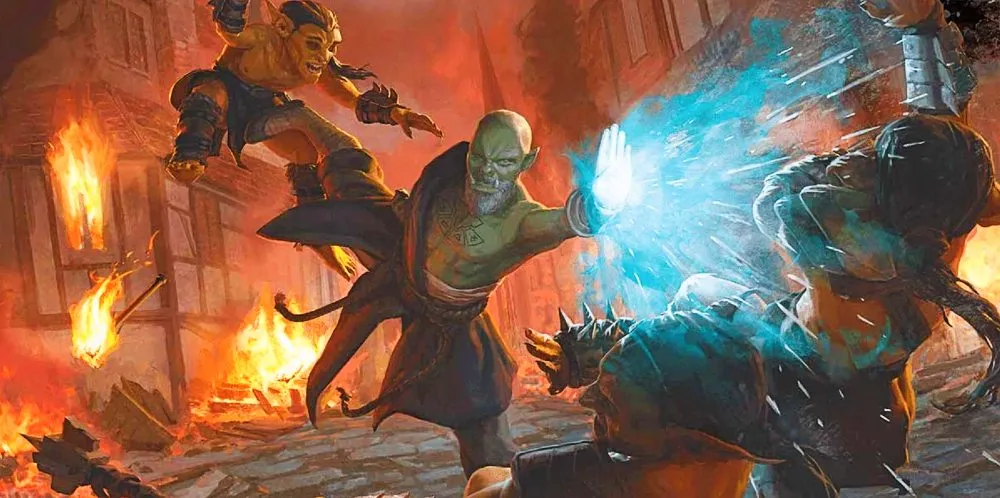Dexterity represents a character’s agility, reflexes, balance, and fine motor skills in DnD 5e. Characters use Dexterity to avoid area-of-effect attacks like a dragon’s breath, move without being seen, perform acrobatic stunts, pick locks, and disarm traps.
Importantly, Dexterity is used as the attack and damage modifier of attacks made with all ranged weapons. It can also be the modifier used with any finesse weapon.
Armor Class
The default armor class calculation is 10 + Dexterity modifier. Armor and some class features can change this calculation. But, as a general rule, Dexterity is important for how defensively sound your character is.
It represents a character’s ability to avoid attacks in combat.
Initiative
Your Dexterity modifier is added to your d20 initiative rolls. This determines the turn order in combat.
Basically, the more dexterous you are, the quicker you’re able to respond to a fight.
This is very important, as going sooner in combat is both an offensive (faster kills) and defensive (less incoming damage) advantage.
Melee Finesse Weapons
| Weapon | Damage | Type |
|---|---|---|
| Dagger | 1d4 piercing | Simple |
| Rapier | 1d8 piercing | Martial |
| Scimitar | 1d6 slashing | Martial |
| Shortsword | 1d6 piercing | Martial |
| Whip | 1d4 slashing | Martial |
Acrobatics
Acrobatics checks cover your ability to stay on your feet in tricky situations. You can also make an Acrobatics check contested by an attacker’s Athletics check attempt to grapple or shove you to avoid being shoved or grappled, or to escape the grapple. Examples include:
-
Escaping/avoiding being grappled
-
Squeezing through tight spaces
-
Staying on your feet or landing on your feet
-
Performing acrobatic tricks and stunts
-
Balancing
Sleight of Hand
Whenever you’re doing something sneaky, surreptitious, and quick with your hands, you’re using Sleight of Hand. Examples include:
-
Stealing something in plain sight
-
Concealing an object
-
Planting an object
-
Magic tricks
-
Juggling, catching, tossing
-
Concealing the somatic component of a spell (DM-dependent)
-
Performing an extra “free” object interaction during combat (DM-dependent)
-
Tying good knots
-
Catching a falling object
Stealth
Stealth can be used to both go unnoticed or to get the jump in a fight. As an unseen attacker, you get attack advantage (but give away your position when you do), so it’s a good way to start a fight.
You make a Stealth check against creatures’ Perception checks to successfully hide from them, but you can’t hide in plain sight; you need to use obscurement and cover to attempt hiding.
-
Hiding
-
Sneaking by creatures without being noticed
-
Slipping away without being noticed
-
Following someone without attracting notice
Examples of Dexterity
-
Stealth. Silent as a breath of wind, Lyra glided through the moonlit alleyways. Her sleek, dark attire blended seamlessly with the shadows, and her elven eyes sparkled with mischief. Though guards patrolled, her silent footsteps left them all unaware of her presence.
-
Sleight of Hand. In the bustling marketplace, Finnian moved with the grace of a dancer. His nimble fingers danced too, adept at weaving through crowds unseen. Finnian thrived on the thrill of sleight of hand. Merchants marveled at their emptied pockets, their treasures now snug in Finnian’s grasp.
-
Acrobatics. Amidst the towering cliffs of Skyreach, Seraphina stood at the precipice. A dragon’s fiery breath descended upon her as the party sought refuge on the narrow ledge. With a swift leap, Seraphina somersaulted through the air, narrowly avoiding the searing flames.

![Intelligence [DnD 5e Basics] intelligence-dnd-5e](https://www.dndlounge.com/wp-content/uploads/2024/02/intelligence-dnd-5e-300x169.webp)
![Strength [DnD 5e Basics] strength-dnd-5e](https://www.dndlounge.com/wp-content/uploads/2024/02/strength-dnd-5e-300x169.webp)
![Charisma [DnD 5e Basics] charisma-dnd-5e](https://www.dndlounge.com/wp-content/uploads/2024/02/charisma-dnd-5e-300x190.webp)
![Constitution [DnD 5e Basics] constitution-dnd-5e](https://www.dndlounge.com/wp-content/uploads/2024/02/constitution-dnd-5e-300x188.webp)